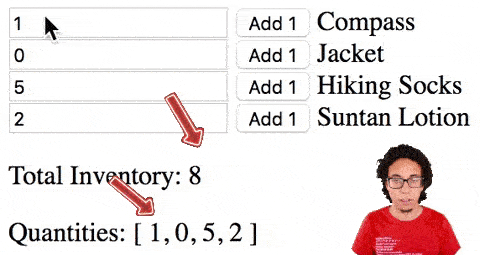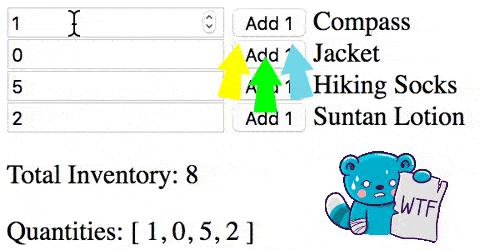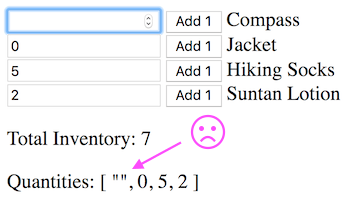Disclaimer: This is a comparison that is far from being exhaustive or unbiased. Similarly to Elm vs. Svelte, it is based on a mini-example taken from a video tutorial.
Is more a comparison of feeling between writing a few lines of codes in these two different frameworks. I didn't know Vue before writing this post, I usually use Elm in my projects.
Let's start with Vue
It is a simple application that send an HTTP request, retrieve a list of products, list them with the stock quantity and let the user either edit the quantity or add 1 to the quantity with a button showing the total of the inventory:
…but
#1 “Total Inventory” doesn’t work
While the “Add 1” buttons work fine, typing number in the input field give wrong result (Demo #1).
For example, let’s type 123... what? Where 01123052 is coming from? I guess someone is trying to concatenate strings instead of adding numbers. Note also that the list of quantities is now [“1123”,0,5,2].
After some research in the Vue documentation I found this:
It sounds exactly what we needed. Let’s add it in our script at line 3:
From
<input type="number" v-model="product.quantity">
to
<input type="number" v-model.number="product.quantity">
Fixed!
#2 “Total Inventory” is broken again!
Now typing digits works, but if we delete all digits we are getting again the same problem discussed above (Demo #2).
Ok, maybe we should refactor the function that calculates the total Inventory.
Let’s add a condition at line 20 that, if the quantity is not a number, the value is skipped.
From
totalProducts() {
return this.products.reduce((sum, product) => {
return sum + product.quantity
}, 0)
}
to
totalProducts() {
return this.products.reduce((sum, product) => {
if (typeof product.quantity === "number") {
return sum + product.quantity;
} else {
return sum;
}
}, 0)
}
Fixed!
#3 The “Add 1” button sometime doesn’t work
The button doesn’t work if pressed after we remove all digits or we type non-numeric characters (Demo #3).
Ok, time to fix this one too. Let’s change the command that add 1 (line 4) from
<button @click="product.quantity += 1">
to
<button @click="product.quantity = Number(product.quantity) + 1">
Fixed!
Vue/Javascript experience
Maybe these issues came from my lack of knowledge of Vue but I was expecting a smoother experience.
Maybe using the magic two-way data binder v-model is not a good practice and we should rather use one-way binding?
Even if the application now works, the array of quantities still contain a mix of strings and numbers, that is a prelude for other issues in the future. For example when this data will be saved permanently somewhere (Demo #4).
Also all the above issues were detected just using the application and not automatically by the development environment. They could have been easily passed undetected and go to production.
Elm experience
This is the code. It consists of two parts, a small html section to load and initialise the page, and the Elm code that will compile to Javascript.
Elm by design forces us to consider all possible cases that the state of code can be in, including the cases that are responsible for the issues above.
The quantities are of type Integer so is not possible to store any string in them.
We need to convert the string that we get from the input field into an integer before saving it. Then we need to convert it back to a string before displaying it in the page.
During the conversion from string to integer things can go wrong, for example when the string doesn’t contain a valid number.
In this case Elm wants to know how we want to deal with such a case.
One of the important part is, as mentioned above, when we convert from string to integer:
{ quantity = Maybe.withDefault product.quantity (String.toInt newQuantity) }
This piece of code says: “If the user typed a valid number, replace the old number with the new one (newQuantity), otherwise keep the old number (product.quantity)”
There is one caveat here: because Elm doesn’t allow any impossible state, it also doesn't allow to delete all the digits from the input field because that would not be a valid number anymore.
This makes it difficult to change the single digit. This could be fixed checking if the string is empty and converting to a 0, for example. But here we would enter into the realm of issues related to the input field of type number.
In any case, the Total Inventory is always correct and the list of quantities always contains numbers, out of the box.
Usually is a good practice to store input field as String in the model and not as Int because String is the "natural" type of values from forms, also when the input text if of type "number".
There are other things that Elm forces us to consider, for example the case when the HTTP request fails, but these go out of the scope of this post so in the code we simple tell Elm to ignore errors:
GotProducts (Err _) ->
( products, Cmd.none )
Closing HTML Elements
One thing that I was not doing for a long time was writing HTML and specifically, remembering to close HTML elements. I the last several years I have been using HAML, Jade, Pug and Elm and all of these systems do not require to close elements.
Working on this example reminded me of the good old days when I was opening a <div> and closing a </p> by mistake.
Typos
While several types of typos will generate a runtime error in Vue, there are others that go undetected. For example changing
<input v-model.number="product.quantity">
into
<input v-model.number="product.quanity">
^^^^^^^
does not show any error but the application is broken: all input fields are empty and typing in them nothing happens. The buttons are still working.
Other errors will only show when interacting on the interface but not on loading.
In Elm basically all typos get detected at compile time, unless they happen inside strings. The above typo generate this error at compile time:
Note the Hint section at the bottom.
Conclusion
Most of these issues come from Javascript but I thought Vue would take a more active role in shielding these from developers. Would TypeScript or Flow fix these issues? Leave your comments below.
This article, in a slightly different form, was initially published in Medium.
Thank you for reading!













Top comments (0)